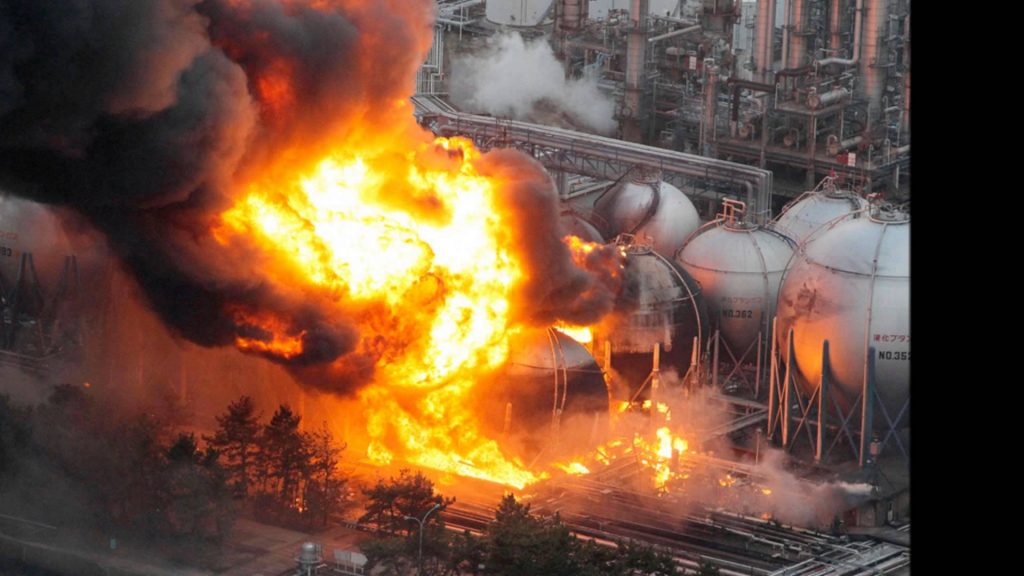Natural disasters are very common but tragic events around the world. From earthquakes to tornadoes, geological disasters can cause increasingly damaging effects, affecting the landscape and those who find themselves there. But when these events are combined with man-made artifacts, the effects might be even greater. An example of this is the Fukushima Disaster in Japan, the worst nuclear disaster since the 1986 Chernobyl incident.1 But the cause of this horrific disaster wasn’t particularly a man-made event. In fact, it all started with a wave.

On March 11, 2011, an earthquake with a magnitude 9.0—the worst to ever hit Japan—hit the country. It was such a powerful catastrophe, that Japan’s main island, Honshu, was permanently moved more than two meters to the east. As the earthquake gained momentum, waves up to 40 meters began crushing the country’s coast. The effects of the earthquake and the waves were too much for the Japanese. More than 20,000 people died or went missing and hundreds of thousands more lost their homes.2 But the worst was yet to come. Fifty minutes after the initial earthquake, a ten-meter high sea wall hit the Fukushima Daiichi (Number One) nuclear power plant. The water flooded the plant’s emergency power generators, knocking vital cooling systems offline, triggering a meltdown of reactor fuel rods. These then leaked deadly radiation into the coastal atmosphere of Japan. With the cooling systems not working, hydrogen gas built up in the reactor buildings, causing several hydrogen explosions in the following days of the earthquake.3

Because of the highly toxic radioactive material that leaked to the surrounding areas of the power plant, the government began to evacuate 80,000 people from a twelve-mile radius. Technicians turned to several things to try to cool the nuclear fuel, like using fresh water, seawater, and injecting nitrogen into the reactor containment buildings to prevent further explosions.4 But despite the efforts to try to help the people of Honshu, the government didn’t tell the people the truth. The official statistics of the event and even the admittance that the meltdown had taken place weren’t disclosed until eighty-eight days later.5
It was estimated that more than 800,000 tons of highly-radioactive material sat near the accident, which was slowly getting into the ground and moving towards the ocean. Although many people were evacuated, there were still many that couldn’t leave. The government installed temporary housing that was intended to house tens of thousands of people after the disaster for twenty-four months. But five years after the disaster, thousands of people were still living where they were surrounded by the radioactive material. Many of those who remained were the elderly and low-income families who had few options to move away.6

Several months after the disaster, people in other parts of Japan began rallying to help these people and bring an end to nuclear power plants in Japan. This pushed forward for the closure of all of the other nuclear plants in Japan for maintenance and inspection.7 These protests also pressured the government to issue a report on the disaster at Fukushima. This report criticized TEPCO (the Tokyo Electric and Power Company) for failing to address concerns about safeguards at the plant. This report also included information about how TEPCO officials had ignored engineers’ concerns that a seawall constructed to protect against major tsunamis as they had seen on March 11 was not sufficient. The report additionally criticized safety regulators for not implementing proper safety measures and for failing to adopt global nuclear safety standards.8 This was really important for the Japanese because TEPCO had always emphasized that the nuclear generators were “fail-safe,” that the facility was completely earthquake resistant and that the reactors would be able to withstand a major tremor.9
Five years after the disaster in Japan, several policies were changed to address the rising concerns of the Japanese population regarding nuclear power plants. The major decision of this kind was the decision to phase-out nuclear power plants during the 2030s as part of Innovative Strategy for Energy and the Environment adopted by the cabinet of the Democratic Party of Japan (DPJ).10 TEPCO is still facing criticism regarding the amount of nuclear material that was leaked into the environment and it is estimated that cleanup operations could take up to forty years.11
- Will Ripley, Junko Ogura, and James Griffiths, “Fukushima: Five Years after Japan’s Worst Nuclear Disaster,” CNN, March 11, 2016, sec. World. ↵
- Encyclopedia Britannica, 2018, s.v. “Fukushima Accident.” ↵
- New World Encyclopedia, 2017, s.v. “Fukushima nuclear disaster.” ↵
- New World Encyclopedia, 2017, s.v. “Fukushima nuclear disaster.” ↵
- Will Ripley, Junko Ogura, and James Griffiths, “Fukushima: Five Years after Japan’s Worst Nuclear Disaster,” CNN, March 11, 2016, sec. World. ↵
- Will Ripley, Junko Ogura, and James Griffiths, “Fukushima: Five Years after Japan’s Worst Nuclear Disaster,” CNN, March 11, 2016, sec. World. ↵
- New World Encyclopedia, 2017, s.v. “Fukushima nuclear disaster,” ↵
- Encyclopedia Britannica, 2018, s.v. “Fukushima Accident.” ↵
- Akira Nakamura and Masao Kikuchi. “What We Know, and What We Have Not Yet Learned: Triple Disasters and the Fukushima Nuclear Fiasco in Japan,” Public Administration Review 71, no. 6 (2011): 894. ↵
- Rie Watanabe, “After the Fukushima Disaster: Japan’s Nuclear Policy Change from 2011 to 2012,” Review Of Policy Research 33, no. 6 (2016): 623. ↵
- Alexis Dudden, “The Ongoing Disaster,” The Journal of Asian Studies 71, no. 2 (2012): 349. ↵




111 comments
Jose Fernandez
I didn’t know about the magnitude of this “natural” disaster. This is very sad because the people who were affected the most don’t have the resources to move somewhere else. I also didn’t know about all the people in Japan that protested against nuclear power plants. I hope this is used as an example by every country that works nuclear energy. The article was well written and was very organized.
kendrick Harrison
I think this is a good example of how trying to save a dollar can sometimes take a turn for the worst. If the Tokyo Electric and Power Company (TEPCO) was informed about concerns from engineers regarding the sea-wall, and they chose not to act, it likely had to do with not wanting to expend the resources (time and money) to correct it. I know nothing about power plants, but it sounds expensive.
However, in hindsight, the price of not fixing the issues turned out to be enormous: 20,000 people killed, 80,000 residents relocated (who may experience life threatening health conditions down the road), damaged property, and an expected 40 year clean up time. This all could’ve been avoided.
I don’t know that this disaster should result in the total removal of nuclear energy, as it was an issue of location, not functionality, but there are definitely lessons to be taken away from it.
Peter Coons
Since Chernobyl, it should be an expectation to those who live around nuclear power plants that a disaster is simply an eventuality. At Fukushima, the utter lack of preparation for an event like this holds too many similarities to every other power plant meltdown. The exception here being that nature was the chief cause of the meltdown. The problem I have with the whole scenario is that Japan, as an island nation in the Pacific, is no stranger to these kind of natural disasters. Why was the plant not built with cataclysm in mind? Why did the builders tout the reactors as “Fail-safe”? And, more importantly, why did it take eight years for the government to admit fault? It seems that the whole situation could have been mitigated from the beginning if they took the lessons learned from the Soviets and at Three Mile Island, and simply decided to apply them.
Nathan Hartley
This disaster affected the rest of the world as well as Japan, and I am happy someone wrote about the article to tell its story. I really like how the article shows how much the tsunami affected the people living in that area of Japan more than just the water damage and the limited power due to the plant being destroyed.
Christopher Vasquez
I was surprised to see that the Japanese government tried to keep the truth about the entire ordeal hidden; to me, complete transparency — especially during a natural disaster — is a must for any government. TEPCO should have been more diligent with their work. Although no one at the time would have thought that Japan would have been devastated by a 9.0 on the Richter scale (unheard of in Japan until this event), the precautions should have been set to that of a 10.0, which would have protected Japan against nearly all earthquakes. I also feel bad for those who had to live in a makeshift home; to have one’s home yesterday but gone today is a sad thought. I hope that whoever was affected by this earthquake has been able to recover in some way.
Jabnel Ibarra
Nuclear power, while having the potential to be an excellent, reliable source of energy has proven time and time again that with great power comes great responsibility. The dangers associated with nuclear radiation are not to be trifled with, and the risk of exposure to radiation by just being in the vicinity of a nuclear power plant isn’t something that can easily be ignored. With that being said, to demand that all nuclear power plants immediately be shut down is both unrealistic and impractical. Nuclear power is technically a renewable source of energy after all, and (provided the facility is well maintained) causes no harm to the environment. The disaster at the Fukushima nuclear power plant was a grim reminder of the importance of proper management for such facilities.
Mariah Garcia
I’ve heard of the Fukushima Disaster, but I never knew how it had affected so many lives. However, it wasn’t just the human life that was affected but the marine life that surrounded the plant. I would like to have known how this disaster affected the marine life since nuclear material did leak into the environment. It is sad to know that this nuclear disaster could’ve been avoided if TEPCO just followed the regulations given by the engineers.
Steven Hale
This story reminds me of hurricane Katrina, and how the failure of the manmade levees, not just the elements, wreaked havoc. I am glad that the Japanese government has established new standards and released a report to the public, but it seems like they should have taken more responsibility. While TEPCO certainly could have done better with the plant’s safeguards, failing to evacuate all the people near the plant falls on the government.
Avery Looney
I remember this disaster when it happened in 2011, but never knew the full story and what exactly happened. This article does a great job of telling what happened at Fukushima and who is held responsible. By TEPCO disregarding safety precautions they put hundreds of thousands of lives at stake. This incident not only hurt thousands of people, but also caused severe damage to the environment. I believe that nuclear energy has more cons than it does pros, and Fukushima is a prime example of that.
Brianna Ford
This article is the first time I am ever hearing about the Fukushima disaster in Japan. It’s sad to hear that more than 20,000 people lost their lives because of the earthquake. I can see why the government would hide the truth from the people, but it also wasn’t right to withhold information when they had the right to know. I also don’t understand why “Tepco” would be so foolish enough to ignore something so miner, that could have been change, effect thousand of others.